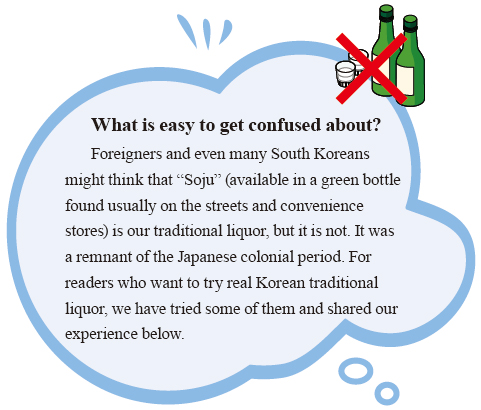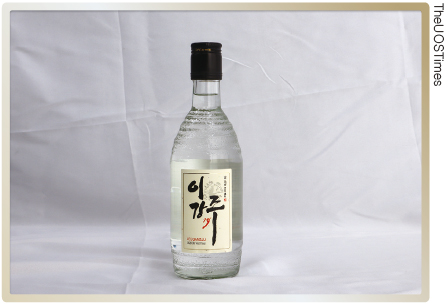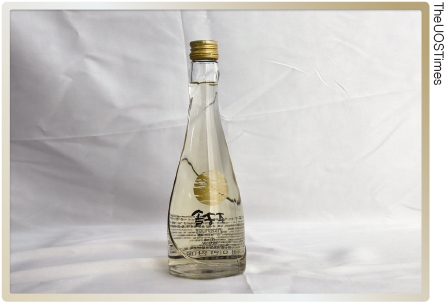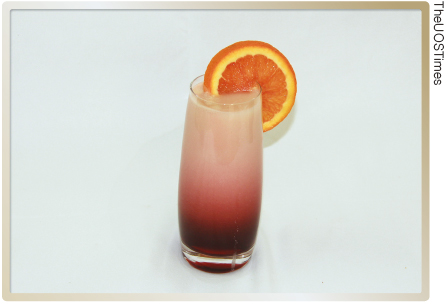Alcohol has played a significant role in human history. Several stories, both historical and fictional, are associated with it that can never be ignored. One example is that of Alexander the Great, who died due to Alcoholism. There is a famous story of Guan Yu in Three Kingdoms who said “I will be back before the glass gets cold” and came back with the enemy leader’s head. Greek and Roman mythology had a God of wine called Dionysus and Bacchus, respectively.

Germany without beer? We cannot imagine that. Liquor has an inseparable relationship with humans. Since liquor is usually made of ingredients that are produced abundantly in a region, they represent that particular region. In the 5000 years of Korean history, we also have had many traditional types of liquor, just as the countries mentioned above. The UOS Times will introduce and review different types of Korean traditional liquor with their history and the delicious side dishes that go well with each type.
What is Korean traditional liquor?
Korean traditional liquor is defined as an “intangible cultural heritage” and made by “traditional food masters” under the Liquor Tax Law. This includes alcohol made from agricultural products with regional characteristics. It refers to the unique liquor that continues in line with its historical background. According to the Korea Agency of Education, Promotion & Information Service in Food (EPIS), Korean traditional liquor can be divided into two major categories based on its manufacturing method: fermented beverage and distilled beverage. The UOS Times will review these in detail later.
It is difficult to categorize all Korean liquors because there are several methods of making them. Hundreds of methods are still continued by each region and culture. Why does this happen? This is because Korean traditional liquor culture started from “homemade liquor.” Korea (or Joseon) has long been a farming community. Most farmers lived in one area, built a sense of community with their neighbors, and enjoyed various traditional and seasonal food cultures, creating unique things for each region. Traditional liquor deeply incorporates the culture and homogeneity of each of these regions. In rural communities, based on self-sufficiency, people have created unique types of alcohol suitable for their climate, staple food, geography, culture, and economy. This liquor was accompanied by local customs and daily life, and was long inherited from villages or certain families.

Brief history of Korean traditional liquor
Our drinking culture has a long history. Before the Three Kingdoms period, Mahan (from the first century B.C. to the third century A.D.) made clear grains. They dedicated them to their ancestors and enjoyed dancing, singing, and drinking. Alcohol was popular in all events even during the Three Kingdoms period. According to the myth of Jumong who founded Goguryeo (one of the countries of the Three Kingdoms period), the liquor of Silla (one of the countries of the Three Kingdoms period) was known among the Tang people. During the Goryeo Dynasty, the brewing methods were imported from China, and the traditional liquors were developed to diversify liquor products.
The characteristic of liquor in the Joseon Dynasty—the last dynasty in Korea—is “high-end.” The raw materials used in manufacturing have been changed from fresh rice to glutinous rice, and the fermentation technology has also changed from the Danyang liquor method (one-time liquor) to the Jungyang liquor method (gives more than two times liquor).
During the Japanese colonial period, the liquor culture was wiped out because of the liquor decree, and we had no choice but to continue the tradition through smuggling. In addition, the Japanese government standardized all alcoholic beverages into extremely limited categories. After liberation, Korean traditional stocks had no place since the liquor administration under the Japanese colonial rule banned the manufacture of homemade liquor due to food shortages and suppression in rice consumption. In 1982, traditional liquors began to be restored after their re-discovery and the designation of intangible cultural assets.

Review
As mentioned above, Korean traditional liquor can be categorized into two major types based on the manufacturing method: fermented beverage and distilled beverage. In this review, The UOS Times will introduce some Korean traditional liquors belonging to both the categories.
Fermented beverage
Fermented beverages are matured by fermenting things such as grains or fruits, sweet potatoes, and potatoes with fungi and enzymes. It has relatively low alcohol content and is prone to degeneration due to humidity and temperature. There are beneficial ingredients in the fermentation process and you can feel the unique taste and aroma of the raw materials.

Bokbunja Makgeolli (Raspberry raw rice wine)
• Taste: It tasted very sour initially, which made us think that it had gone bad. However, the aftertaste was very good. The sweet, clear taste spread all over the mouth, and I could not stop drinking it. It felt like I only had a couple of cups, but the bottle was already empty. It is recommended to those who hesitate to try Makgeolli.
• Texture: It was not very murky or thick, unlike other regular Makgeolli. As raspberry is added, it has a beautiful red-pink color.
• With what: Kimchi Jeon goes well with this drink. Kimchi’s spice goes well with its sweet taste.
Neulin Ma-eul Makgeolli (Slow Village raw rice wine)
• Taste: It tastes sweet and light; therefore, I feel that I will not have a hangover even if I keep drinking. The taste is likely to be made by a Makgeolli master, but it is actually a new generation of Makgeolli with breweries all over the country. In addition, it is soggy with many grains. The UOS Times does not recommend it to people who want to drink light alcohol. I gave it a try after hearing that it topped the list of sales.
• Texture: Very thick and cloudy just like other Makgeolli.

Bulg-eun Wonsung-i Makgeolli (Red Monkey raw rice wine)
• Taste: It is light, and the soda taste of traditional Makgeolli is rarely felt. Even if you hold it in your mouth, you cannot feel the bitter taste because it does not use an artificial sweetener, but gets the sweetness from rice, and makes you feel healthy. If you are new to the Makgeolli world, The UOS Times recommends this one.
• Texture: Thick. Since the wine is red, you might think it contains some fruit; but actually it is red because it is made of red rice.
Distilled beverage
Distilled beverages have pure alcohol. The traditional distillation method involves heating the liquor, placing a device called a soju-ring on it, and collecting steam from the heated liquor at the base to collect a purer and clearer undiluted solution. It is produced in cold areas because the alcohol content is high and is suitable for heat generation.

Andong Soju
• Taste: It has a unique alcoholic scent, which some people would love but some would hate. Regular Soju (green bottle) also has a similar scent and some people do not like it, but the scent of Andong Soju is much stronger. It seems to be very bitter judging only by its scent; however, it tastes sweet, unlike what is expected. Nevertheless, it could be difficult for those who are trying traditional liquor for the first time.
• Texture: Clear and transparent. High-end texture.
• With what: Andong Jjimdak (Andong steamed chicken in soy sauce). Both Andong Jjimdak and Andong Soju are from Andong; therefore, The UOS Times recommends this combination to those who visit there.

Leegangju
• Taste: When we took the first sip, something came to our minds: “Ginger tea with a lot of alcohol.” As of its ingredients include pears, ginger, and cinnamon, it has a clear and distinctive taste. It was sweet at first, but the aftertaste was slightly bitter.
• Texture: Transparent and clean.
• With what: Beef tartare would be a nice choice.

Solsongju
• Taste: It tasted like chewing living pine trees and drinking alcohol at the same time. We never thought it would be that bitter. There is a beverage that tastes like toothpaste called “Pine bud Drink” which is very divisive among Koreans. Solsongju is “Pine bud Drink” plus bitter alcohol. If someone is trying traditional liquor for the first time, this should not be the one.
• Texture: Clear, yellowish.
• With what: Cannot imagine anything that can go with this liquor.
Customized beverage
There are other ways to enjoy Korean traditional liquor. Making cocktails is one of them. The UOS Times made a “Flaming Sunset” cocktail combining Makgeolli, grenadine syrup, cranberry juice, and Crème de cassis.

Flaming Sunset Cocktail
• Taste: It does not taste very sweet even though it contains quite a lot of syrup. Cassis seems to neutralize the sweetness. It is moderately sweet and will make you drink more and more without noticing. You will enjoy it much more if you add the joy of the process of making it. You will be able to enjoy a sweet taste and a good mood.
This review is based on the personal impressions of the reporters. Liquors that are said to have an awful taste in this article could taste nice to others such as the readers or professionals in alcohol. Considering that, try as many Korean traditional liquors as possible and find your taste. For those who want to do this, The UOS Times has a recommendation: there is a Korean traditional liquor gallery called “The Sool Gallery”; and “Sool” is the Korean word for liquor. Every month, they select five traditional liquors and hold free tasting sessions. You can try different traditional liquors there, and can even create your own cocktails. If anyone wants to learn Korean traditional culture, trying Korean liquor could be a great start.
Sim Jun-sung
dnsen07@uos.ac.kr

